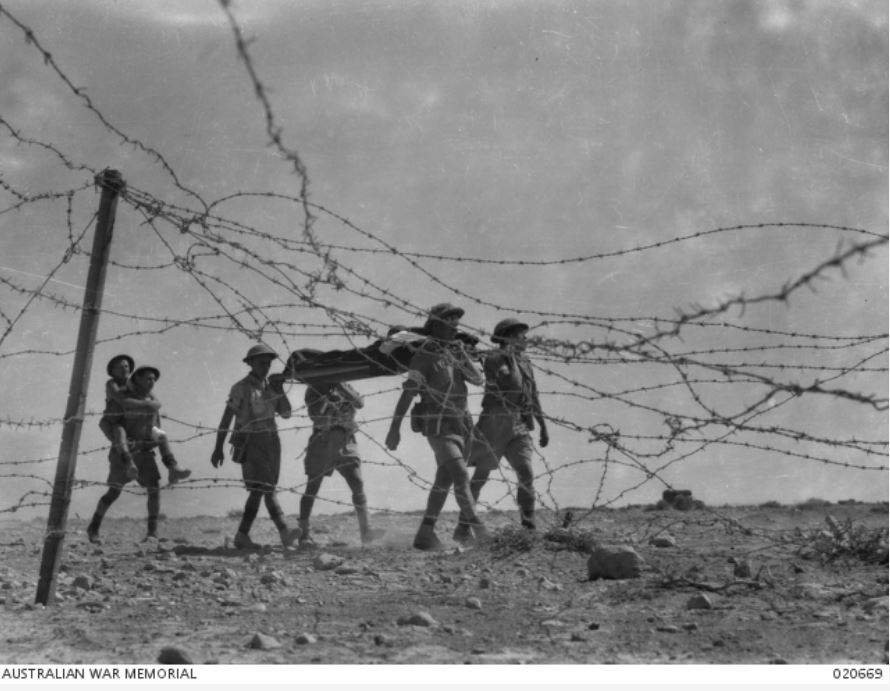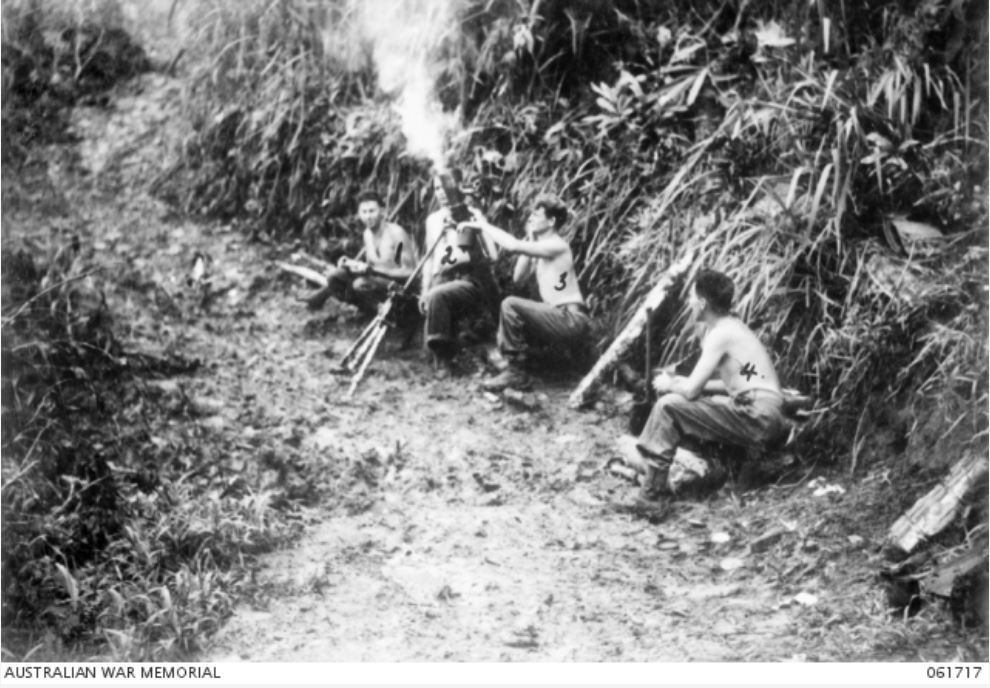2/23rd Australian Infantry Battalion
From Our Contribution
 17 Sep 1941 Tobruk, Libya Wounded coming back through wire. AWM photo 020669 | |
 10 Dec 1943 Peak Hill New Guinea. 2/23rd Mortars firing on Japanese positions. AWM photo 061717 | |
Contents
Brief History
The 2/23rd Australian Infantry Battalion was raised at the Albury Showgrounds during August 1940, as part of the 26th Brigade. Initially the brigade belonged to the 7th Division but in early 1941 it was re-allocated to the 9th Division. Initial training was undertaken near Albury prior to moving to Bonegilla, Victoria. From there they sailed for the Middle East in November 1940.
In early 1941 the battalion, along with the rest of the 9th Division, moved into Cyrenaica to complete its training and then to defend against German-led forces. As pressure increased, the 9th Division fell back to Tobruk. The 2/23rd Battalion's sub units entered Tobruk between 6 and 10 April 1941. The battalion helped defend Tobruk for eight months. Its heaviest fighting occurred while defending the Salient from 20 August to 9 September, and again from 17 September to 3 October.
In October 1941 the majority of Australian units in Tobruk were evacuated by sea. The 2/23rd left on 18 October and sailed to Alexandria. The division was transferred to Palestine and then Syria for rest and garrison duties. By July 1942 German and Italian forces had reached El Alamein in Egypt. Consequently, the 9th Division was rushed from Syria to the El Alamein area where it held the northern sector for almost four months.
In July the 26th Brigade advanced along the coast, driving a wedge between the sea and the German positions by capturing the feature known as "Tel el Eise", which ran north-west between the railway line and the sea. During the main offensive from 23 October to 4 November the 26th Brigade and, further south the 20th Brigade, moved in a sweeping arc towards the sea. The heaviest fighting occurred at the "Saucer". By the end of the October the 26th Brigade had suffered heavily and was relieved by the 24th Brigade on 1 Nov 1942. The 2/23rd had lost 29 men killed, 172 wounded, and six missing. But, by 6 November Axis forces were retreating. With the entry of Japan into the war, the 9th Division was now needed elsewhere and it returned to Australia. Leaving Alamein on 2 Dec 1942 they first headed back to Gaza in Palestine, before leaving in the third week of January 1943 for Sydney which it reached at the end of February.
Re-organised for jungle operations in New Guinea, on 4 Sep 1942 the 2/23rd Battalion participated in the division's amphibious landing at Red Beach, north west of Lae. Following the landing the 2/23rd Battalion participated in the fighting around Lae, Finschhafen, and Sattelberg. After Sattelberg, the 2/23rd Battalion continued to move inland, capturing Masangkoo, Kuanko, and finally on 9 Dec 1943, Wareo.
The 2/23rd then returned to Australia in February 1944. After some leave, the battalion reformed during June in Queensland at Ravenshoe on the Atherton Tablelands, waiting to participate in actions north of New Guinea. After a long wait, in April 1945 the 2/23rd Battalion was transported to Morotai, the staging area for amphibious landings on Borneo. The 26th Infantry Brigade landed on Tarakan on 1 May 1945 with one of the lead units the 2/23rd Battalion. As a result of the massive pre-invasion air and naval bombardment, early progress was made as they pushed towards Tarakan townsite. However, from 6 May to 16 June the mountain ridges behind the town were the scene of bitter fighting. The island was divided into areas which each unit had to clear of any remaining Japanese survivors. The 2/23rd's area of responsibility was in the centre of the island, between the Juata Oilfields and the airfield on the west coast.
Following Japan's surrender, the ranks of the 2/23rd thinned, before those who remained returned to Australia in December 1945. The 2/23rd Battalion was disbanded at Puckapunyal on 17 Feb 1946.
Battalion Personnel
- Lewis Hinsley 5 Jul - 29 Sep 1945
Battle Honours
- North Africa 1941-42
- Defence of Tobruk
- The Salient 1941
- Defence of the Alamein Line
- El Alamein
- South West Pacific 1943-45
- Lae-Nadzab
- Busu River
- Finschhafen
- Sattelberg
- Wareo
- Borneo
- Tarakan
Individual Honours
- 3 x Distinguished Service Order
- 1 x Member of the Order of the British Empire
- 11 x Military Cross
- 4 x Distinguished Conduct Medals
- 20 x Military Medals
- 1 x EM
- 33 x Mentioned in Despatches
Notes
Content has come from The Unit Guide - Volume 2 - The Australian Army 1939-1945, pages 2.315 - 2.318 - Graham R McKenzie-Smith - Big Sky Publishing - 2018